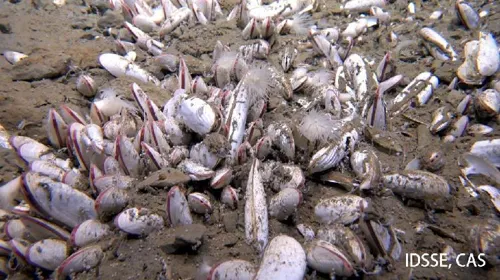Chinese Team Finds Chemical-Eating Creatures 10000M Undersea

In an extraordinary breakthrough, a Chinese research team has unveiled vibrant communities of marine life thriving at an astonishing depth of nearly 10,000 meters beneath the ocean surface. This discovery highlights a previously unknown abyssal ecosystem that flourishes without sunlight, relying instead on chemical reactions for sustenance.
The innovative study, which adds significant contributions to the field of marine biology, was published on Wednesday in the prestigious scientific journal 'Nature.'
Conducted by the Institute of Deep-sea Science and Engineering (IDSSE) under the Chinese Academy of Sciences, the research showcases the deepest-known chemosynthetic life communities on Earth. These organisms derive their energy from chemical reactions occurring within geologic fluids.
The ecosystems observed primarily consist of tube worms and bivalve mollusks that feed on fluids abundant in hydrogen sulfide and methane, demonstrating a remarkable adaptation to extreme conditions.
To achieve this groundbreaking exploration, the team utilized China's manned submersible Fendouzhe, or 'Striver.' They successfully reached a record depth of 9,533 kilometers and surveyed an expansive stretch of the trench floor spanning 2,500 kilometers in the Kuril-Kamchatka and Aleutian trenches.
Geochemical analysis from the study indicated that methane found in these extreme environments is generated by microorganisms residing deep within sediment layers. These microorganisms continuously convert carbon dioxide that results from the decomposition of organic matter, hinting at a vast and active biosphere lurking beneath the abyssal seafloor.
This discovery presents a significant challenge to the long-standing belief that abyssal ecosystems primarily hinge on organic particles and animal remains descending from the ocean surface. It provides a new perspective on the intricate mechanisms powering the deep-sea carbon cycle.
Moreover, the findings suggest that chemosynthetic organisms may play a crucial role in shaping the structure of abyssal ecosystems while also impacting the global carbon cycle.
This research forms a key part of the Global Hadal Exploration Programme (GHEP), an ambitious decade-long initiative led by the IDSSE. The program is dedicated to unraveling the mysteries of the Earth's deepest oceanic zones through advanced deep-diving technologies.
Read These Next

AI Reveals Earth's Secrets by Chinese and French Scientists in Paris
Chinese and French scientists, led by Razvan Caracas, use AI to study Earth’s formation, emphasizing volcanic activities' role.

China's Ambitious Plan for Zero-Waste Cities Development
China is creating 'zero-waste cities' to enhance recycling and minimize landfill use, engaging over 113 cities in this effort.

Rise of Life-like Robots: Beijing's New Robot Mall Launch
This article explores the launch of Robot Mall in Beijing, focusing on the sale of life-like robots and the broader implications for society and technology.
